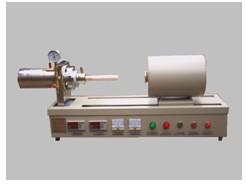
This advanced instrument integrates computer technology and intelligent single-chip microcomputer systems to monitor and control the entire process of physical quantities, including displacement and temperature. It supports both offline operation and automatic online testing, running seamlessly in a Chinese Windows environment with an intuitive and user-friendly interface. In offline mode, it can be tested using smart meters or manually. This device is primarily used for determining the thermal expansion coefficient of ceramics, refractory materials, and other solid substances, especially corundum, refractory materials, casting shells, and core materials.
The instrument offers a range of advantages, such as automation, ease of use, quick testing, data printing, archiving, and a rich database that allows easy modification and search of experimental results. It provides modern testing methods for ceramic and refractory products, supporting both industrial and research applications.
Key technical specifications include:
- 1. Furnace temperature range: Room temperature to 1000°C
- 2. Heating rate: 0.1–20 K/min, with standard rates kept below 5 K/min; custom options available
- 3. Parameters such as heating rate, process control, PID settings, and communication methods are fully adjustable, set, and locked. Parameter modifications are performed via the host computer.
- 4. Expansion measurement range and accuracy: ±5mm ±0.1%, ±2.5mm ±0.1%
- 5. Temperature control accuracy: ±1°C, with a recording error of ≤ ±0.5%. Different heating elements and temperature control methods are used at various temperatures.
- 6. Expansion measurement resolution: 1 µm per digit, with an optional 0.1 µm per digit setting
- 7. Sample size: Length up to 50 mm or 25 mm, diameter between 6–8 mm
- 8. Test atmosphere: Vacuum (10â»Â¹ mbar), static, dynamic; inert or reactive gases; vacuum conditions can be customized
- 9. Sample state: Solid or powder (with mold)
- 10. Sample holder: Available in quartz, alumina, or other materials as required
- 11. Operating system: Compatible with Windows XP/98
- 12. Designed to accurately measure material expansion or contraction during heat treatment, suitable for ceramics, resins, building materials, glass, refractory materials, metals, and alloys
With the DP-III model, users can perform a variety of tests, including thermal expansion coefficient analysis, softening temperature determination, sintering kinetics studies, glass transition temperature evaluation, phase transitions, density changes, and sintering rate control (RCS). This makes it a versatile tool for material scientists and engineers working in both laboratory and industrial environments.
Material: Ceramic bonsai pots are typically made from clay that has been fired at high temperatures. This results in a durable, yet porous material that allows for adequate airflow and moisture regulation for the bonsai tree's roots. Ceramic pots come in various colors, textures, and finishes, providing options to match different bonsai tree species and personal preferences.
Size and Shape: Bonsai pots come in a range of sizes and shapes to suit different bonsai tree styles and sizes. The pot's size should be proportionate to the size of the bonsai tree and its root system, providing ample room for root growth while maintaining aesthetic balance. Common shapes include rectangular, oval, round, and square, with variations such as cascade pots for cascading-style bonsai trees.
Design and Style: Ceramic bonsai pots come in a variety of designs and styles to complement different bonsai tree species and aesthetic preferences. They may feature traditional Japanese-inspired motifs, modern minimalist designs, or intricate patterns and textures. Some pots are hand-painted or glazed to enhance their visual appeal, while others feature natural earthy tones or rustic finishes.
Drainage Holes: Proper drainage is essential for the health of bonsai trees, as excess water can lead to root rot. Most ceramic bonsai pots come with drainage holes at the bottom to allow water to escape freely. Additionally, some pots may include wire or mesh screens over the drainage holes to prevent soil from washing out while still allowing water to drain.
Weather Resistance: Since bonsai trees are typically kept indoors or in sheltered outdoor locations, ceramic bonsai pots do not require the same level of weather resistance as outdoor pots. However, they should still be durable enough to withstand indoor conditions such as temperature fluctuations and humidity.
Weight: Ceramic bonsai pots can vary in weight depending on their size and design. While smaller pots are generally lightweight and easy to handle, larger pots may be heavier and more challenging to move. The weight of the pot can also provide stability for the bonsai tree, preventing it from tipping over easily.
Maintenance: Ceramic bonsai pots require minimal maintenance but may benefit from occasional cleaning to remove dust, dirt, or mineral deposits. A gentle wipe with a damp cloth is usually sufficient to keep the pot looking its best. Avoid using harsh chemicals or abrasive cleaners that can damage the glazed surface of the pot.
Cost: The cost of ceramic bonsai pots can vary depending on factors such as size, design, craftsmanship, and brand. While they may be more expensive than basic plastic or terra cotta pots, ceramic bonsai pots are considered a worthwhile investment for bonsai enthusiasts looking to enhance the presentation of their trees.
Overall, ceramic bonsai pots combine functionality with aesthetic appeal, providing a suitable and stylish container for showcasing bonsai trees while enhancing the overall beauty of the display. Their versatility in design and size makes them a popular choice for bonsai enthusiasts of all levels.
Glazed Bonsai Flower Pot ceramic , Ceramic Bonsai Pot for cultivating bonsai trees
Yixing Bocai Pottery Co.,Ltd , https://www.bocaipottery.com